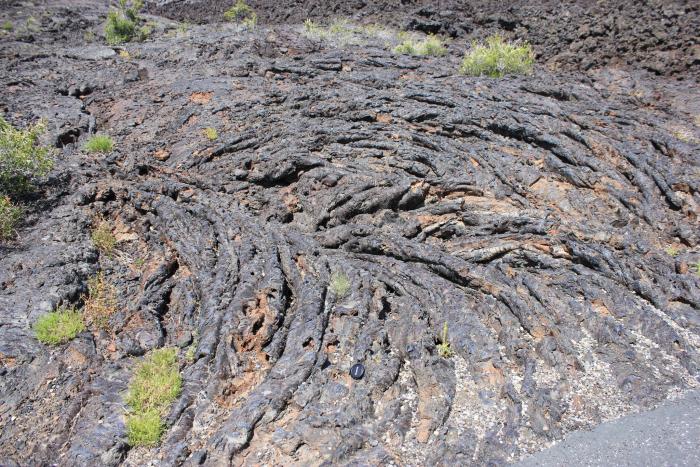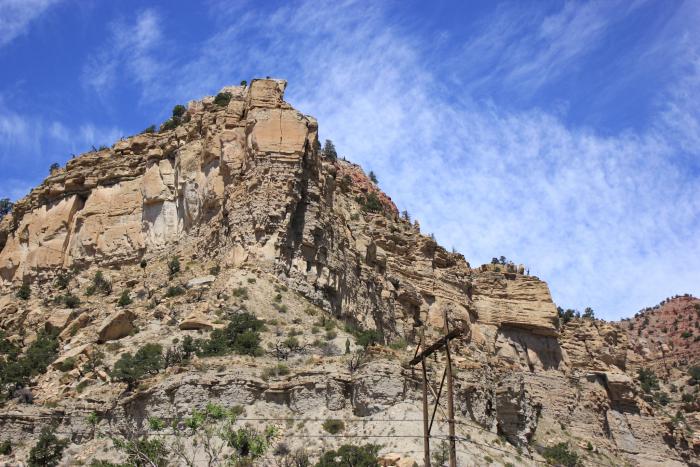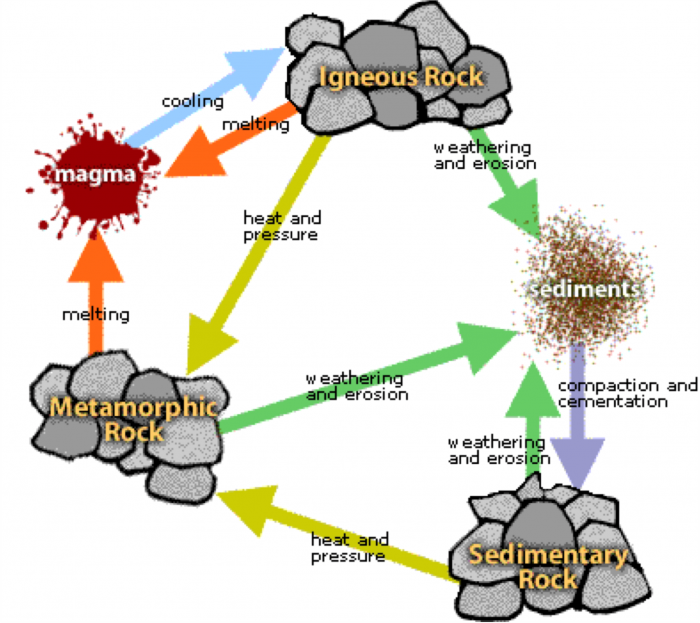Rock Types
Rocks are aggregates of minerals and minerals are naturally-occurring inorganic solids having a distinct chemical composition with an ordered crystalline arrangement. In other words, minerals are made up of molecules with repeating series that form a crystalline structure which exists as rock. Common minerals include quartz, consisting of two silica atoms and one oxygen atom to form sand grains which when cemented together form sandstone. You can have very large quantities of a particular mineral or a mixture of minerals to make rock. There are three broad categories of rocks including igneous, sedimentary, and metamorphic rock, as described below.
Igneous Rocks
Igneous rocks start as molten minerals formed deep in the earth under intense heat and pressure. The melt originates deep within the Earth near active plate boundaries or hot spots, then rises toward the surface. Igneous rocks are divided into two groups, intrusive or extrusive, depending upon where the molten rock solidifies.
Intrusive Igneous Rocks:
Intrusive (or plutonic) igneous rock forms when magma is trapped deep inside the Earth. Large masses of molten rock rise toward the surface where some of the magma may feed volcanoes on the Earth's surface, but most remains trapped deeper in the earth where it cools and solidifies very slowly over many thousands or millions of years. The slow cooling time allows the mineral grains to grow over a very long time and become relatively large giving them a coarse-grained texture.
Extrusive Igneous Rocks:
Extrusive (or volcanic) igneous rock is produced when magma rises and cools at or near the Earth's surface, such as erupting volcanoes and oozing fissures. The magma is called lava when it erupts on the surface, which cools and solidifies it almost instantly (known as quenching) which means that mineral crystals don't have much time to grow and are very fine-grained, sometimes even having a glassy texture (e.g.)obsidian. Gas bubbles are often trapped in the quickly cooled lava, forming a vesicular texture.
The igneous rocks in this picture form what is called a pahoehoe (pronounced pah-hoy-hoy) flow, or a smooth, undulating, ropey texture.

Sedimentary Rocks
Sedimentary rocks are made up of grains that are derived from mechanically or chemically breaking down other igneous, metamorphic and.or sedimentary rocks through weathering, or can be made up of chemically mineralized fragments of ancient organisms such as coral. Physical weathering occurs when rocks are exposed to rain, wind, temperature changes, and roots and broken down into their basic components forming grains of rock. Chemical weathering dissolves rocks down into more basic elemental components. The grains are transported downstream, eventually settling out in a basin, or low energy environment (for example a lake or an ocean) and over time, as more sediment is deposited, layers of sediment are buried deeply enough to be turned into stone, a process known as lithification. Because features of the environment are preserved in the sediments, we can tell something about where the rock was deposited. For example, a rock with leaf fossils preserved must have been formed in a slow, stagnant environment - one in which the leaves would not be disturbed or moved away. Sedimentary rocks are all about what remains. As we will discuss later, black shales are organic-rich sediments that form in marine settings, where there is very little wave energy and very little oxygen to preserve the organic material, which ultimately forms hydrocarbons with enough heat, pressure and time.
Sedimentary rocks often have distinctive layering or bedding. Many of the picturesque views of the desert in the southwest United States show mesas and arches made of layered sedimentary rock.
The sedimentary rocks in this picture have been tilted.

Metamorphic Rocks
Metamorphic rocks are sedimentary, igneous or even metamorphic rocks that have been deformed with intense heat and pressure, which can cause minerals in the rocks to recrystallize. Metamorphic rocks form in mountain belts (collision zones) where rock is compressed or buried, along fault planes, along subduction zones, near igneous rock as the neighboring rock is cooked, to name a few. For example, marble is a metamorphic limestone (a chemical sedimentary rock consisting of calcium carbonate). Slate is a metamorphic form of shale and is often found in classroom chalkboards.
Each of these rock types relies on the others in some way.
Take a few minutes to watch this fun video that describes the three types of rock and how they are connected.
Video: Geology Kitchen: The 3 Types of Rocks (8:35)
You know rocks are a lot like people. They come in all sorts of shapes and sizes. But we really need a way to characterize those rocks and lump them into groups. What we have here are three basic rock types, igneous rocks, sedimentary rocks, and metamorphic rocks. And today I'll talk a little bit more about each.
Igneous rocks are the most primitive type of rock. They form deep within the earth from hot molten rock called magma. In order to demonstrate how magma forms, first we need to transition something from a solid state, like this chocolate bar, to a liquid state. In order to do that, we need to heat it up. We'll do is take this chocolate out, put it in our pan, and apply some heat. Now that we've added heat to our chocolate, we've changed it into a liquid. Magma changes to a liquid under very intense heat and pressure at depth. What we're going to do is simulate the cooling of magma using this cold ice cream. The ice cream would be the equivalent of the temperature at the surface. I'm sure the surface is not this cold, but compared to the heat of the chocolate it's not such a bad analogy. Now what we're going to do is we're going to pour this hot chocolate over this cold ice cream. And we're going to do what happens in real life. When magma cools it crystallizes and changes back into a solid. We have to wait a few minutes. Now that we've had a chance to let our chocolate magma cool a bit let's take a look and see if we've reverted back to a solid. It looks like we have. So, we heat the magma at depth, and we bring it up and we cool it. And if we cool it quickly, like this, the chocolate actually forms a very fine-grained crystalline solid. If we were to cool it very slowly, in the earth we actually get coarse-grained rocks like granites, where you can see large crystals within the rock. In the basalt, like this one from Hawaii, you can see that these cool fairly quickly. So they have a finer grain texture. So, as you can see, igneous rocks are pretty cool. Well after you put them in the refrigerator.
If igneous rocks form deep in the earth, sedimentary rocks form right at the surface, as water and air break up pre-existing rock and create sediment. Sedimentary rocks are created from sediment, as well as from biological activity, things like fossils, and from chemical activity in places like lakes, where the water dries up and leaves behind salt or gypsum. These are the sedimentary rocks and today we'll really quick make a sedimentary rock. What you need are grains of some pre-existing rock. In this case, we have some rice cereal that serves as our sand grains. And make sure they're sand because the word sand means that they are a certain size. Yeah, that's about two millimeters or so. It's a little coarse for sand but it's close enough. Anything bigger than sand would be considered gravel or cobble in size. These covered candies here will be our gravel. So as a river comes in and pours this stuff into a basin, we mix this stuff up. What we end up with is a rock containing many different types of sand and gravel, silt, and clay-sized particles. Those are what we call the classic sedimentary rocks and are the majority of the sedimentary rocks that we see around us today.
The last group of rocks are called metamorphic rocks. And metamorphic rocks are formed from preexisting rocks, which are altered by high heat and pressure. Usually, in the earth, it's from burial deep within the earth. It can also be through volcanics or other ways that we can heat up the rocks to really intense temperatures and then create new minerals and new textures within the rock. Today we're going to attempt to create a new metamorphic rock from our pre-existing rock. Here we've got our bear stone, we've got our worms down here, and we've got our s'moresite over here, which is a nice combination of marshmallows, chocolate, and graham crackers. Now what we're going to do is we're going to bury these deep within the earth, on this plate, and create a new rock. We've got this nice hard graham cracker, you've got to have a good base for it, chocolate. And what we're going to do is we're going to apply heat, we're going to apply pressure. In a kitchen, applying heat and pressure at the same time it's a little difficult. We could have used a pressure cooker, but, you know, that wouldn't be that much fun would it? So we're going to do it a little more inventive way. And we've layered these rocks like a sedimentary rock, where we have different layers of things on top of each other. And the first thing that we're going to do is we're going to apply some heat. We're going to do that using the microwave. Let's heat this thing up and see what we're gonna get.
Now that we've added some heat to our rocks, let's pull it out of the microwave and add a little pressure. The pressure is an issue. We need to add some pressure and I think the way that I'm going to do that is I'm going to actually put a little human pressure on this. Put this in place, like so. Put this plate here. I really wanna get a lot of pressure on it. I think I'm a big guy. Why don't we do this? All right, just gonna stand up here. The more pressure that we add, the more we can deform those different rocks. And now that they're hot they'll mutate and mix and fold and disfigure themselves into something completely different. Okay good enough, I guess, for demonstrations sake. I'll get down here without killing myself. Let's see what we have. Hopefully, something that looks like a gooey metamorphic rock. The gelatin and the corn syrup within the candies, it's like a lot of minerals that, at fairly low temperatures and pressures, melt and move around within the rock, almost forming cement. And if you can see here, we've got the graham cracker which pretty much stayed the way it was. Now we've got new layers of marshmallow and candy, that in a natural metamorphic rock, you can see these folds and gooey shapes that obviously this rock was under such intense heat and pressure that the rock itself looked something like this. It was a gooey, hot, very big mess. That's what it was. So metamorphic rocks are interesting in that you can take pretty much anything and make one, as long as you have a lot of heat and/or pressure.
So today we've looked at the three basic rock types: igneous rocks which cool deep within the earth from magma, or in volcanoes at the surface; sedimentary rocks which form from the erosion of pre-existing rocks and redeposition as sediment, or from biological activity or from precipitation and water; and metamorphic rocks, the third type, formed from pre-existing igneous sedimentary and metamorphic rocks which are buried deep. The intense heat and pressure cause them to change into a completely new rock.
So guys, thank you and keep rocking out in your kitchens.
Activity: Make a concept map!
Think about the interaction between igneous, sedimentary, and metamorphic rocks, and spend a few minutes drawing a picture that draws attention to relationships between these rocks. After you’ve given it a go, check out the concept map below! What is different between your concept map and this one? Do these differences surprise you?
